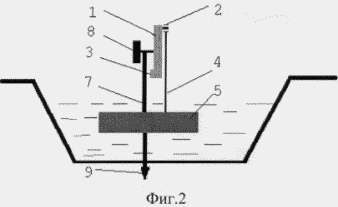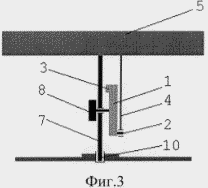| Start of section
Production, amateur Radio amateurs Aircraft model, rocket-model Useful, entertaining |
Stealth Master
Electronics Physics Technologies Inventions |
Secrets of the cosmos
Secrets of the Earth Secrets of the Ocean Tricks Map of section |
|
| Use of the site materials is allowed subject to the link (for websites - hyperlinks) | |||
Navigation: => |
Home / Patent catalog / Catalog section / Back / |
|
INVENTION
Patent of the Russian Federation RU2293212
![]()
DEVICE FOR CONVERSION OF RENEWABLE ENERGY
The name of the inventor: Strekalov Sergey Dmitrievich (RU); Misharev Gennady Mikhailovich (RU); Strekalova Lyubov Petrovna (RU); Tarasov Alexander Nikolaevich
The name of the patent owner: Strekalov Sergey Dmitrievich
Address for correspondence: 403013, Volgograd region, Gorodishchensky borough, st. Cherry, 145, OPH "Novozhiznenskoye", S.D. Strekalov
Date of commencement of the patent: 2005.08.04
The invention relates to devices for converting renewable energy and can be used to generate energy from an air flow (from the wind) or a liquid flow (water flow). The technical result consists in simplifying the design, increasing the energy efficiency of the flow, ease of operation and reducing the negative impact on the environment. The device consists of a receiving surface, a connecting rod connected to a crank shaft and a connecting link. The receiving surface is rigidly fixed to the connecting rod along its direction, the connecting rod being connected to the crank shaft by one end, the second end being pivotally connected to the connecting link, and the receiving surface is curved, with the concavity facing the flow direction.
DESCRIPTION OF THE INVENTION
The invention relates to devices for converting renewable energy and can be used to generate energy from an air flow (from the wind) or a liquid flow (water flow).
There are known flow energy converters made in the form of vane or rotor turbines (Shefter YI Inventor about wind turbines and wind turbines, M., Ministry of Agriculture .- 1957. - P.33-34).
There is also known a transducer comprising a wind-receiving rotation plane and a crank-rod transmission connected to it and a power take-off shaft, characterized in that it further comprises a second crank gear and the cranks of the two gears are disposed to each other at an angle not exceeding 180 °, And the connecting rods are connected to the edges of the turning plane (AS No. 1240949, BI # 24 dated June 30, 1986).
Disadvantages of this system are the complexity of the design, low energy utilization of the flow, the complexity of operation.
The technical problem of the proposed invention consists in simplifying the design, increasing the energy efficiency of the flow, ease of operation and reducing the negative impact on the environment.
The technical task is achieved by the fact that the receiving surface is rigidly fixed on the connecting rod along its direction, the connecting rod being connected to the crank shaft by one end, the second end is pivotally connected to the connecting link, and the receiving surface is curved, with the concavity facing the flow direction.
 |
 |
 |
1 shows a general view of the device from the side, FIG. 2 shows a diagram of an installation in the hydrogenerator mode (front view); FIG. 3 shows a diagram of an installation in a wind turbine mode (front view). FIG. |
The device includes a flywheel 1 on which the crank 2 is fixed and a balancer 3. The crank is hingedly attached to the connecting rod 4, on which the curved sensing surface 5 is rigidly fixed, with the concavity facing in the direction of flow. The second end of the connecting rod is hingedly connected to a connecting link 6 hingedly attached to the frame 7. A mechanical energy converter (electric generator, pump, heat generator, etc.) is fixed to the frame.
In the mode of the hydrogenerator (FIG. 2), the receiving surface is located at the bottom, the frame is supported by the support 9 into the bottom of the reservoir.
In the wind turbine mode (FIG. 3), the receiving surface is located at the top, the support frame 10 is fixed to the ground surface.
The device works as follows. Power flow, acting on the receiving surface 5, rigidly connected with the connecting rod 4, causes its movement, with the movement of the crank 2 fixed on the flywheel 1 causing its rotation. When the leftmost position is reached, the angle of inclination of the receiving surface changes and the flow begins to move it to the extreme right position. When the receiving surface of the extreme right-hand position is reached, the cycle of its movement is repeated. The cyclic movement of the receiving surface leads to the rotation of the flywheel, whose uniformity of rotation is achieved by balancing by introducing a balance bar. From the flywheel shaft, the motion is transferred to mechanical energy converters (electric generator, pump, heat generator, etc.). The presence of a balancing (stabilizing) flywheel allows smoothing the input parameters of the electrical converter, which gives a more stable output parameters.
The use of a converter of renewable energy from the flow of air or liquid will improve the efficiency in comparison with the paddle converters due to the use of a more perfect cycle of motion.
Reducing the negative impact on the environment is achieved by eliminating the rotation of the blade, accompanied by noise and swirls of the flow.
The simplicity of manufacturing the receiving surface is achieved by the fact that all its sections make identical trajectories of motion.
The separation of the energy and receiving devices allows to completely eliminate the need for sealing joints and rotating assemblies, which increases the durability of use and facilitates the possibility of maintenance of wind and hydro installations.
CLAIM
1. A device for converting renewable energy, consisting of a sensing surface, a connecting rod connected to a crank shaft and a connecting link, characterized in that the receiving surface is rigidly fixed to the connecting rod along its direction, the connecting rod being connected at one end to the crank shaft, the second end hinged Is connected with a connecting link.
2. The device according to claim 1, characterized in that the receiving surface is curved, with the concavity facing towards the flow direction.
print version
Publication date 16.02.2007gg




Comments
Commenting on, remember that the content and tone of your message can hurt the feelings of real people, show respect and tolerance to your interlocutors even if you do not share their opinion, your behavior in the conditions of freedom of expression and anonymity provided by the Internet, changes Not only virtual, but also the real world. All comments are hidden from the index, spam is controlled.